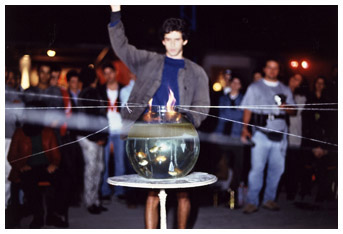


 |


launch interview with Cabelo
Cabelo is a cultural seismographer, creating public performances and sculptural environments that chart the fault lines and energy flows of the physical, psychic, and geographic spaces of his life in Brazil. After studying, and abandoning, engineering and then vermiculture (earthworm farming), Cabelo undertook the study of poetry and performance at the Parque Lage in Rio de Janeiro. It is the merging of these two very different backgrounds--the scientific and the aesthetic--that gives Cabelo's work its particular power.
Poetry is central to Cabelo's work and he speaks about his performances and environments as manifestations of the poetic in the physical world. By referring to himself as a cabello, or horse, he invokes the use of this word to describe a medium that embodies a spirit in certain Afro-Brazilian rituals. In this sense the artist suggests that he is himself a "horse of the world" or "poetry's vehicle." Like the earthworms he previously raised, which process waste into nurturing fertilizer by consuming it, Cabelo thinks of the artist as a conduit through which poetry can enter the world and in so doing transform it.
For Cabelo, the human body is very much like a radio receiver--bombarded with invisible lines connecting it to the invisible transmissions of energy sources emanating from the world around us. As the artist has stated, "I'm possessed by entities, energies, acting jointly or separately. Like one or two soccer teams. The combination of forces guides the body." His performances seek to channel these transmissions into the visible world by con-cretizing them into both plastic and poetic forms. In his performance Cefalópode/Heptópode (1996), for example, the artist and his cohorts transformed themselves into human worms, crawling through the streets of Rio de Janeiro at dusk with their legs and heads bound in black plastic. At the conclusion of this intervention, they crawled into an abandoned cinema where an ambient rock band theatrically performed a rap song with lyrics appropriated by the artist from Charles Baudelaire's poem "Les Fleurs du mal." Works such as this can be read in a number of different ways: as a critique of urban homelessness or an alchemical invocation of the poetic.
Cabelo has been the subject of a number of solo exhibitions at venues such as Galeria Paulo Fernandes, Rio de Janeiro (2002), and Galeria Luisa Strina, São Paulo, Brazil (1999). His work has also been included in a number of group exhibitions including Violência e Paixão at Museu de Arte Moderna, São Paulo (2002); Côte à Côte: Art Contemporain du Brésil at CAPC Musée d'art contemporain, Bordeaux, France (2001); and Documenta X, Kassel, Germany (1997).
--Douglas Fogle











